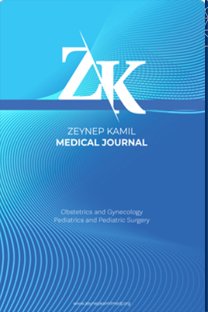Evaluation of gestational trophoblastic diseases; 10 years’ experience in tertiary obstetric care center
Evaluation of gestational trophoblastic diseases; 10 years’ experience in tertiary obstetric care center
___
- 1. Seckl MJ, Sebire NJ, Fisher RA, Golfier F, Massuger L, Sessa C. Gestational trophoblastic disease: ESMO clinical practice guidelines for diagnosis, treatment and follow-up. Ann Oncol 2013;24(Suppl 6):vi39–50.
- 2. Shen D, Liao X, Liu Y, Wang H, Yu Y. Clinicopathological study of intermediate trophoblastic non-tumor lesions: Exaggerated placental site and placental site nodule. Zhonghua Bing Li Xue Za Zhi 2004;33(5):441–4.
- 3. Ngan HY, Seckl MJ, Berkowitz RS, Xiang Y, Golfier F, Sekharan PK, et al. Update on the diagnosis and management of gestational trophoblastic disease. Int J Gynecol Obstet 2018;143(Suppl 2):79–85.
- 4. Ning F, Hou H, Morse AN, Lash GE. Understanding and management of gestational trophoblastic disease. F1000Res 2019;8:F1000 Faculty Rev–428.
- 5. Eysbouts YK, Bulten J, Ottevanger PB, Thomas CM, Ten Kate-Booij MJ, van Herwaarden AE, et al. Trends in incidence for gestational trophoblastic disease over the last 20 years in a population-based study. Gynecol Oncol 2016;140(1):70–5.
- 6. Savage P, Williams J, Wong SL, Short D, Casalboni S, Catalano K, et al. The demographics of molar pregnancies in England and Wales from 2000-2009. J Reprod Med 2010;55(7–8):341–5.
- 7. Lybol C, Thomas CM, Bulten J, van Dijck JA, Sweep FC, Massuger LF. Increase in the incidence of gestational trophoblastic disease in The Netherlands. Gynecol Oncol 2011;121(2):334–8.
- 8. Altman AD, Bentley B, Murray S, Bentley JR. Maternal age-related rates of gestational trophoblastic disease. Obstet Gynecol 2008;112(2):244– 50.
- 9. Gockley AA, Melamed A, Joseph NT, Clapp M, Sun SY, Goldstein DP, et al. The effect of adolescence and advanced maternal age on the incidence of complete and partial molar pregnancy. Gynecol Oncol 2016;140(3):470–3.
- 10. Eagles N, Sebire NJ, Short D, Savage PM, Seckl MJ, Fisher RA. Risk of recurrent molar pregnancies following complete and partial hydatidiform moles. Hum Reprod 2015;30(9):2055–63.
- 11. Gadducci A, Lanfredini N, Cosio S. Reproductive outcomes after hydatidiform mole and gestational trophoblastic neoplasia. Gynecol Endocrinol 2015;31(9):673–8.
- 12. Eskicioğlu F, Artunç Ülkümen B, Çalık E. Complete blood count parameters may have a role in diagnosis of gestational trophoblastic disease? Pak J Med Sci 1969;31(3):667–71.
- 13. Abide Yayla C, Özkaya E, Yenidede I, Eser A, Ergen EB, Tayyar AT, et al. Predictive value of some hematological parameters for non-invasive and invasive mole pregnancies. J Matern Fetal Neonatal Med 2018;31(3):271–7.
- 14. Zhang L, Xie Y, Zhan L. The potential value of red blood cell distribution width in patients with invasive hydatidiform mole. J Clin Lab Anal 2019;33(4):e22846.
- 15. Soylu Karapınar O, Şilfeler DB, Dolapçıoğlu K, Kurt RK, Beyazıt A. The effect of molar pregnancies on platelet parameters. J Obstet Gynaecol 2016;36(7):912–5.
- 16. Ghassemzadeh S, Kang M. Hydatidiform mole. In: Stat Pearls. Treasure Island, FL: Stat Pearls Publishing; 2021.
- 17. Memtsa M, Johns J, Jurkovic D, Ross JA, Sebire NJ, Jauniaux E. Diagnosis and outcome of hydatidiform moles in missed-miscarriage: A cohort- study, systematic review and meta-analysis. Eur J Obstet Gynecol Reprod Biol 2020;253:206–12.
- 18. Kirk E, Papageorghiou AT, Condous G, Bottomley C, Bourne T. The accuracy of first trimester ultrasound in the diagnosis of hydatidiform mole. Ultrasound Obstet Gynecol 2007;29(1):70–5.
- 19. Shih IM, Kurman RJ. The pathology of intermediate trophoblastic tumors and tumor-like lesions. Int J Gynecol Pathol 2001;20(1):31–47.
- 20. Liu G, Yuan B, Wang Y. Exaggerated placental site leading to postpartum hemorrhage: A case report. J Reprod Med 2013;58(9–10):448–50.
- 21. Takebayashi A, Kimura F, Yamanaka A, Takahashi A, Tsuji S, Ono T, et al. Exaggerated placental site, consisting of implantation site intermediate trophoblasts, causes massive postpartum uterine hemorrhage: Case report and literature review. Tohoku J Exp Med 2014;234(1):77–82.
- 22. Ozdemir O, Sari M, Selimova V, Ilgin B, Atalay C. A case report of complete mole with co-existent exaggerated placental site reaction and review of the literature. Niger Med J 2014;55(2):180–2.
- 23. Pramanick A, Hwang WS, Mathur M. Placental site nodule (PSN): an uncommon diagnosis with a common presentation. BMJ Case Rep 2014;2014:bcr2013203086.
- ISSN: 1300-7971
- Yayın Aralığı: Yılda 4 Sayı
- Yayıncı: Ali Cangül
Serum endocan concentration in women with placenta accreta
Önder TOSUN, Evrim BOSTANCI, İsmail DAĞ, Enis ÖZKAYA, Çetin KILIÇÇI, Ahmet ESER, Çiğdem YAYLA ABİDE, İlter YENİDEDE
Negative pressure wound therapy in gynecological oncology
Sevgi KOÇ, Cihat Murat ALINCA, Taner TURAN, Caner ÇAKIR, Dilek YÜKSEL, Çiğdem KILIÇ, Nurettin BORAN, Günsu KİMYON CÖMERT, Fulya KAYIKÇIOĞLU
Çağatay NUHOĞLU, Nevzat Aykut BAYRAK, Erkan YETMİŞ
Anaphylaxis that develops following application of egg white on an area of burn
Zeynep Şengül EMEKSİZ, Serap ÖZMEN
İbrahim KALE, Cumhur Selçuk TOPAL
Foreign body in esophagus of children with previous esophageal surgery history
Ayşenur CELAYİR, Olga Devrim AYVAZ, Bekir ERDEVE
Ahmet KALKIŞIM, Gökhan ÇELİK, Betül ÖNAL GÜNAY, Cenap Mahmut ESENÜLKÜ
Comparison of outcomes of frozen-thawed transfer of day 5 blastocysts and day 6 blastocysts
